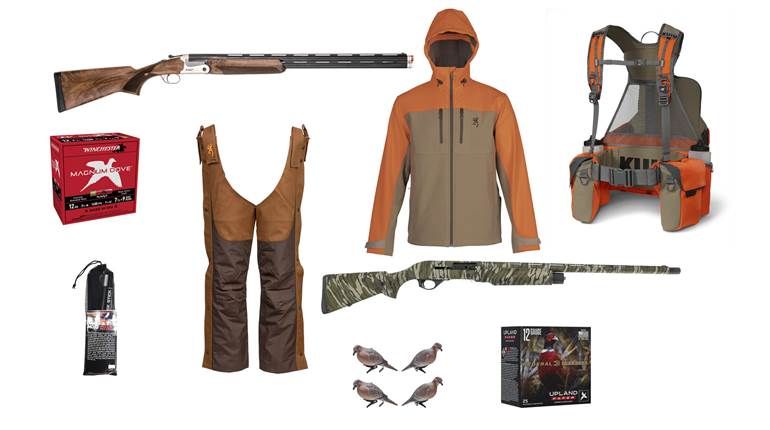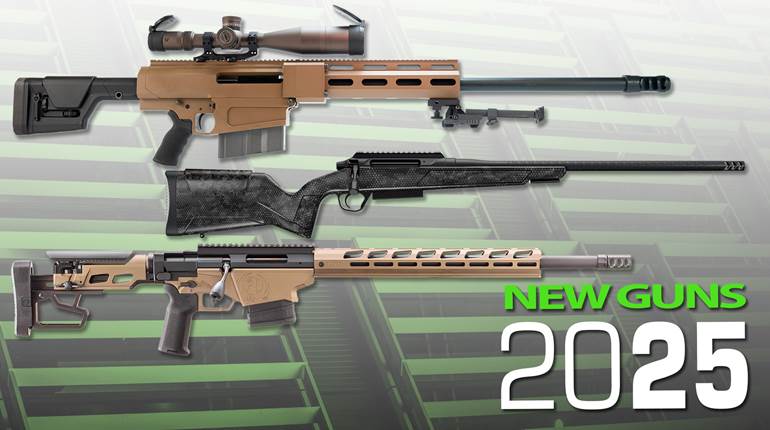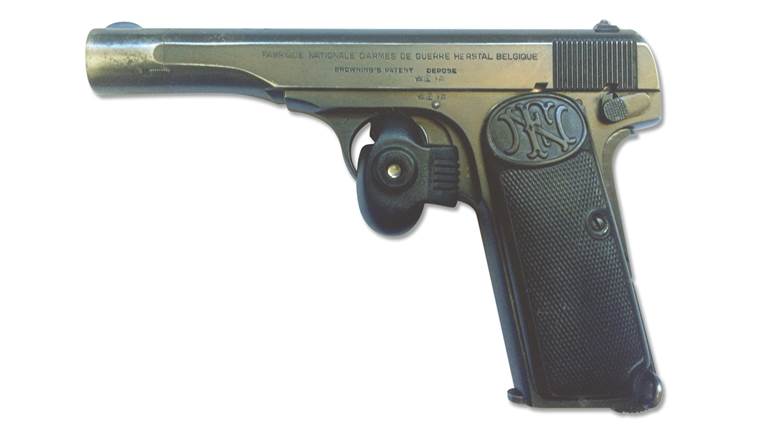
Shown here (clockwise from top) are: a Browning family photograph showing John Browning holding his prototype; an English mahogany case for the British Large Model 1899 trials pistol; a Large Model 1899 pistol (No. 2) for British trials; a Large Model 1899 pistol (No. 7) for Belgian trials; a transition 1899/1900 prototype shipped to John Browning for approval; a factory instruction book for the Model 1899 with cleaning rod and early 7.65 mm ammunition box; an FN Model 1899 pistol (No. 21); and an FN factory screwdriver for the Model 1899.
From a marketing standpoint, the year 1899 must not have seemed very exciting, especially with the advent of a new century. But, in the history of semi-automatic pistols, it was monumental. It marked the world’s introduction to the first Browning pistol, produced by Fabrique Nationale (FN) of Herstal, Belgium—and the first time a pistol was manufactured and sold featuring the revolutionary concept of a slide.
It all started two years earlier, in 1897, when FN was forced to diversify and manufacture commercial products. Previously, the company had only manufactured military Mauser rifles and carbines. In order to survive, FN explored a wide range of products that it could produce as part of its diversification efforts. Some of the best-suited products were bicycles, which were popular at the time. Instead of competing with other bicycle producers, FN opted to offer a more innovative design.
The company sent Hart O. Berg, its sales director and a native of Connecticut, back to the United States to meet with the Pope Bicycle Co. Berg’s ultimate goal was to acquire production rights to a revolutionary new “Chainless Bicycle.” The Pope company, which was best known for its line of Columbia bicycles, had just acquired rights to a British patent for a geared bicycle that did not require a drive chain.
Berg was successful in his negotiations with Pope, and acquiring production rights to the chainless bicycle made it possible for FN to manufacture an innovative and profitable product within a very short period of time. Timing was important, as FN was in a precarious financial and legal situation.
More importantly, Berg had yet another card up his sleeve. Berg knew John Browning from his days in Hartford, and he tried to convince Browning to take his latest design to FN instead of selling it to Colt’s. Despite John Browning having never been involved in international dealings, he trusted Berg and agreed to work with FN.
This decision was not as radical as it may seem; Browning had already sold several pistol designs and patents to Colt’s, but the company had opted to delay production indefinitely. Browning was known to enjoy selling his designs in his stores in Utah, and the fact that none of his earlier pistol designs had yet been produced by Colt’s was certainly a sore point. Not only did Berg offer to get the gun into production, but he also promised royalty payments.
The dealings between the two men in 1897 are some of the most pivotal events in FN’s history. Without the successes of Berg, FN certainly would not have survived the test of time. The revolutionary pistol came with hundreds of rounds that Browning had custom made. Initial testing both overwhelmed and thrilled FN engineers and management—the pistol functioned flawlessly, firing 500 rounds without malfunction.
Berg had negotiated on the company’s behalf, and FN immediately agreed to produce the pistol, pay production royalties and transfer a deposit to the Browning brothers. Although it was relatively easy to make, FN spent more than a year working on the logistics, including manufacturing the new 7.65 mm Browning cartridge invented by Browning. This later became known in the United States as the .32 ACP when introduced by Colt’s in 1903. As a military supplier, FN had no commercial sales network in place, and it took considerable time setting up dealers and agents worldwide.

During 1898, FN showed prototypes to the Belgian military, which was considering adopting a new sidearm, and FN was well-aware of the marketing advantages it would garner if the model was adopted as a military sidearm.
While Belgian military trials were gearing up for 1899, FN went ahead and launched the pistol commercially in January 1899. At the time, it was simply known as the Pistolet Browning. It was an instant success, with 3,900 pistols shipped to dealers worldwide in the first year.
Despite growing popularity and sales, FN remained focused on the Belgian military trials, of which a series were conducted throughout 1899. The small Browning pistol systematically eliminated its competition, including revolver designs by the Nagant brothers and Henri Pieper, as well as pistols from Luger, Bergmann, Roth and Mannlicher.

Despite the pistol’s stellar performance, the Belgian military had a laundry list of requests. Because of the transition from revolvers to an unfamiliar system—a semi-automatic pistol—the military required highly visible safety markings. Other changes included larger stocks that could be removed with a standard screwdriver, the addition of a lanyard staple and ring, more magazine witness holes, and a reinforced frame. The military determined that the frame could crack under extensive use.
Those changes were requested over a period of several trials, and the matter of the pistol’s size remained controversial. Many felt that it was too compact and should be enlarged. Fabrique Nationale acquiesced and built seven large-frame trials pistols, each of which would eventually be part of domestic and international trials and evaluations.
This oversize model was about 15 percent larger and had a magazine that held an additional round. Some of the features requested by the Belgian military were incorporated into the large models, but, ultimately, it was never adopted or mass-produced at FN. The Belgian military settled on the standard size with the requested changes, and designated it the Model 1900. That nomenclature was also immediately adopted by FN.
The maker was, however, not comfortable with the design changes and sent at least one pistol to John Browning for approval. Browning did not oppose the changes but thought that the reinforced frame was pointless.
The year 1900 was exhilarating at FN; it produced the Browning pistols (commercial Model 1899 and military Model 1900), the chainless bicycle and an advanced automobile with brakes, a round steering wheel and a reverse gear. All were considered innovative and were a grandiose success at the World’s Fair in Paris in 1900. Fabrique Nationale was awarded three grand prizes, which elevated the company’s name recognition, including that of Browning, worldwide.
But FN was not good at clearly defining its products. Numerous names were used internally and externally, which became more and more confusing over the years. Finally, some structure was introduced in 1908, and models started to be differentiated by model years.
By then, several models were being produced, and these were known by a confusing array of terms including: the (Old) Browning Pistol; the New Browning Pistol; the Large Model; the War Model; the Vest Pocket; the Forerunner, etc. Factory documents started referring to the “Model 1899”—years after production had ceased—in order to differentiate it from the Model 1900.
Initially, the Model 1900 was to remain strictly a military pistol. Aside from the magazine and some minor parts, the Model 1900 shares no common parts with the Model 1899. The Model 1899 remained in production through 1901, until FN decided to streamline production in 1902. It was more economical to offer only the Model 1900 for both military and commercial sales.

The 1899 Survivors
Despite time, wars, conflicts and destruction, a large quantity of Model 1899 pistols survive worldwide. Most reflect significant wear but are still in operating condition. Some, however, are unique.
John Browning’s original prototype: It was returned to John Browning at the turn of the century and was a personal favorite. His son, Val, recalled how he carried the pistol in his pocket around town. A family photo shows the hand of John Browning holding the prototype, and is marked on the back: “This is the picture of Papa’s hand. 3 of Nov. 1900.” The pistol is now on public display at the John M. Browning Firearms Museum in Ogden, Utah.
Model 1899 No. 19: The oldest production pistol was part of the Belgian military trials, and it was engraved and presented to an officer. It can be seen at the Royal Museum of the Armed Forces and Military History in Brussels, Belgium, and is displayed in its custom FN wooden display case with original tools and a replacement magazine.
Model 1899 No. 21: Made in January 1899, it is the oldest known Browning pistol that was sold commercially.
Large Model 1899 (Internal No. 7): One of only seven Large Models made, it was part of late Belgian trials, and features the requested safety markings, lanyard staple and synthetic stocks.
Model 1899/1900 transition prototype No. 02: This pistol was shipped to John Browning for his approval of the requested Belgian military changes. It shows the reinforced frame, lanyard staple and stock screws, but still has Model 1899 stocks, as FN did not yet have the new stock panel model.
Model 1899 No. 271: This is a standard commercial pistol made in spring 1899 in its original early presentation case. While many Model 1899 pistols survive, less than a handful survive in like-new condition with the optional presentation case and tools.
Large Model 1899 (Internal No. 2): One of only seven Large Models made, it was part of British trials in 1900. It remained in England after the trials and was documented in England in 1934.
Presentation Model 1899 No. 8664: This pistol was produced in 1900 and has factory-commissioned engraving. Fabrique Nationale did not offer engraving commercially until 1903; this presentation pistol for President Theodore Roosevelt—also an NRA Life member—is the only known original engraved Model 1899 pistol.
The circumstances surrounding the gift are not known, but may have originated with John Browning. Like many Model 1899 pistols, it is often misidentified as a Model 1900. It is now on public display at the NRA’s National Sporting Arms Museum at Bass Pro Shops in Springfield, Mo.
Special thanks to the John M. Browning Firearms Museum, the NRA National Firearms Museum, Luke Mercaldo, Carlos Vergara and Alan Kinckiner.



















![Auto[47]](/media/121jogez/auto-47.jpg?anchor=center&mode=crop&width=770&height=430&rnd=134090788010670000&quality=60)
![Auto[47]](/media/121jogez/auto-47.jpg?anchor=center&mode=crop&width=150&height=150&rnd=134090788010670000&quality=60)
















